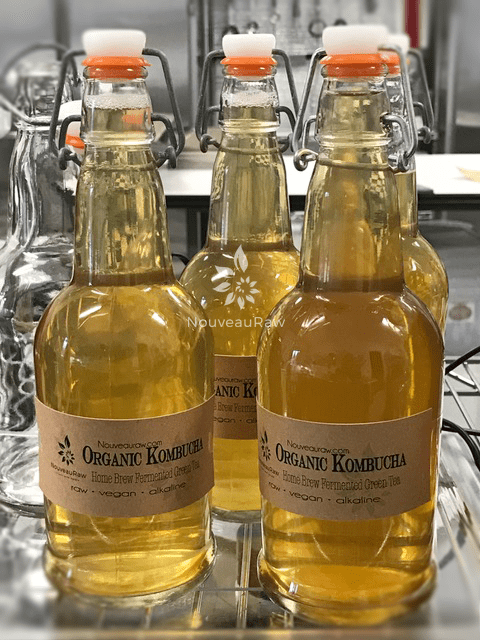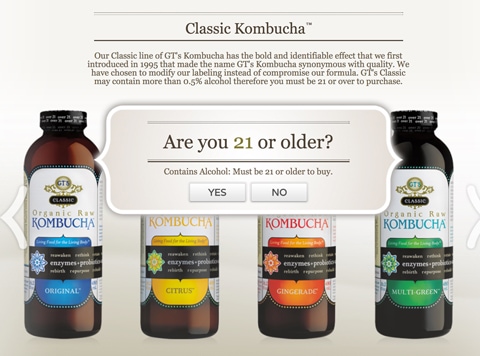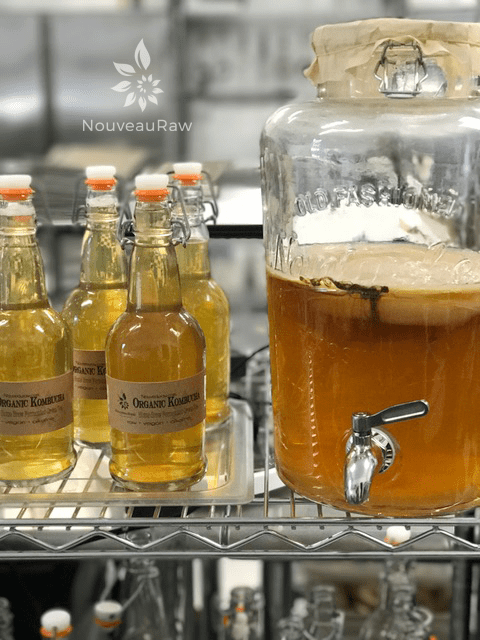


 Add to favorites
Add to favorites
 Kombucha is a fermented tea (yes, this stopped me in my tracks for many years learning that). It’s made with a starter culture called a SCOBY (Symbiotic Colony of Bacteria and Yeast), also referred to as a mother. Just like raw apple cider vinegar.
Kombucha is a fermented tea (yes, this stopped me in my tracks for many years learning that). It’s made with a starter culture called a SCOBY (Symbiotic Colony of Bacteria and Yeast), also referred to as a mother. Just like raw apple cider vinegar.
It is a probiotic of life’s energy. Pro = in favor of, biotic = life. Just like lemons, Kombucha is acidic, but with the synergism of digestion, kombucha becomes an alkaline forming food.
It is tangy, sweet, and tart, with a touch of effervescence. Once the microorganisms in the SCOBY act on the sweetened tea, there really is nothing tea-like about this drink. You can create endless flavors once you get the process started.
For ideas, or if you’ve never tried kombucha before, motor on over to the grocery or health food store and look at their kombucha selection. This will give you some good flavor ideas. The key is to try a few different brands and flavors because just trying one, won’t give you enough of an idea of its potential.
Frankly, my husband (Bob), has never liked kombucha but after I started brewing our own, he has fallen in love. And that’s the beauty of making your own because you can reduce or increase the brew time, tailoring it to your taste buds!
My very first run in with kombucha was back in culinary school, 2007? Where the heck do all the years go? Anyway, we were weeks into our schooling and for upwards of eight hours a day, we were nonstop creating and taste-testing recipes. You can imagine what effect this had on my digestive system. One day, I started to feel those effects, and my tummy was flip-flopping like a fish out of water. I had to excuse myself from the kitchen and go sit down.
 Bob came out to check on me, and he suggested that I go down to the cafeteria and find something “grounding” to either eat or drink. As I waddled my way into the cafeteria, I found myself standing in front of the beverage cooler. The cool air rolling out from it felt inviting and welcoming. Not knowing what I wanted or even if anything sounded good, I spotted a bottle of kombucha. I had no clue what it was, other than a fellow student had previously told me that she drinks it daily and just loved them.
Bob came out to check on me, and he suggested that I go down to the cafeteria and find something “grounding” to either eat or drink. As I waddled my way into the cafeteria, I found myself standing in front of the beverage cooler. The cool air rolling out from it felt inviting and welcoming. Not knowing what I wanted or even if anything sounded good, I spotted a bottle of kombucha. I had no clue what it was, other than a fellow student had previously told me that she drinks it daily and just loved them.
So, not to waste any more time, I grabbed and bottle and headed back up to class. I positioned myself at the table so I could still view what all the students were doing, while I worked on settling my tummy. I drank half a bottle of kombucha, and that’s when it hit me… a BUZZ! This was an unfamiliar feeling for me, but dang, I felt good! I hopped up and slid back into my cheffy position with the other students.
A little time passed, and Bob looked at me and inquired as to how I was feeling. As I slammed the palm of my hand on the counter, and with a huge grin on my face I announced that I felt great! It took Bob by surprise… as well as myself. What was in this kombucha?! And why was I feeling a bit buzzed? I approached the gal in class who told me that she drank it every day and asked her why I was feeling so light and dingy, I mean, airy. It was then that she informed me that there is a small percentage of alcohol in it. Only 0.5% (possibly more) but it was enough to effect this lightweight who never partakes of alcohol. Nowadays, Synergy who makes the brand I drank, split their production creating the Classic and the Enlightened label, The Classic stating that you must be over 21 years of age to purchase it.
So that was my introduction to kombucha. After that bottle, I tried some other brands, which back then, kombucha wasn’t as large of a craze as it is today, and found that I just didn’t care for it. So I skipped a handful of years of ever having it again. It was then that I realized that every brand came with its own unique flavor and some I liked and some I didn’t. I am also a label reader and was always in search for the lowest amount of sugar possible, so I found myself drinking the Synergy brand… the version where you don’t have to present your ID to purchase. Hehe, After forming a healthy, but somewhat expensive, habit of consuming kombucha, I decided it was time to make my own. I am a chef after all. And here we are!
A live raw kombucha ferment is a true serendipitous adventure. It is never static, forever changing. So it’s safe to say that not all kombucha cultures will contain the same strains. The best method to achieve the widest possible range while maintaining the semi-sweet elixir is the Continuous Brewing Method.
 Here is a list of possible benefits, but not just limited to:
Here is a list of possible benefits, but not just limited to:
Kombucha Continuous Brew Method
Kombucha Maintenance of Continuous Brew
Kombucha SCOBY – Growing from Scratch
Testing Sugar Levels in Kombucha
Bottling Kombucha from a Continuous Brew
Second Fermentation of Kombucha – Adding Flavor & Effervescence
Hi Amie, you are so classic and sophisticated in every way considering you are talking about Kombucha :D). I just love you for bringing Kombucha to a brighter and magnified height in the field of its humongous health benefit. I rremember when I first started (looooong time ago), when no one would dare touch my “mushi” babies (I called my scobies because they look like floating portabellos so soft, yet sturdy and slippery to touch hehehe :D). The sad thing most was, nobody would adopt my mushi babies and start their own Kombucha health tonic journey. Health awareness has come a long way since then and now, Kombucha comes in different flavors.
Kudos to you my firend❣️ The Kombucha moms are flipping and clapping in their own ways as they happily multiply their mushi babies anywhere, everywhere where they are loved and cherished quietly and most reverently. They are soooo precious and beyond descriptions, when it comes to giving life and health to mankind.
Thank you Annie for such a wonderful message. I just loved reading what you had to share. hehe I love kombucha but it took me a while to get on board with making it. I love to watch people’s faces when they look at my brewing vessel like I am growing an alien. haha Speaking of which, I think I am going to go bottle some.
Have a wonderful day, amie sue
Can you tell me how it could become dangerous? How would I know if I’m growing bad strains of bacteria? I’m new and growing my scobies but didn’t know I could do something wrong and it could be dangerous. Ty!
Hello Ann,
The important thing when fermenting anything is to make sure all your equipment is CLEAN or you can grow harmful bacteria or mold. One thing you can do is to check the pH level which needs to stay between 2.5 and 4.2. You can purchase PH strips online. Other than that you should always watch for signs of mold that is black, gray, brown, green, or even blue. Look for discoloration or spores. Smell… if you notice an odd or off-putting smell (not normal kombucha vinegar-like smell). You can do some Googling of “bad kombucha scobies”, click on IMAGES and you can start to learn what looks bad. I hope this helps. blessings, amie sue